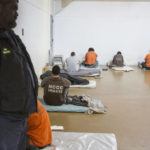Overcrowding at HCCC ‘a serious and immediate concern’


A report by the Hawaii Correctional System Oversight Commission details the effects of chronic overcrowding at Hawaii Community Correctional Center in Hilo.
The report was released Friday after commissioner Ted Sakai, the former state prisons director, and Christin M. Johnson, the commission’s newly hired oversight coordinator, toured the jail for two hours on Aug. 25.
The report noted “severe safety and security concerns,” “lack of programs and basic services,” deficiencies in recreational opportunities and “a complete lack of humane treatment and decency as a whole towards individuals with potentially self-harming ideations and/or actions.”
“This is of particular concern given the recent string of successful suicides within the Hawaii correction system,” the report said.
The report also expressed “a serious and immediate concern involving the safety of those who work and live at Hawaii Community Correctional Center.”
The most recent population report, released Monday, said HCCC had a total of 326 inmates, 279 men and 47 women, in a facility designed to house 206 people, a 158.2% occupancy rate. When calculating the official occupancy rate, the state uses what it calls the “operational capacity” of 226 inmates, which leads to an occupancy rate of 144.2% — making HCCC by far the state’s most crowded jail.
The state’s weekly population reports include both the HCCC main campus near Hilo High School and the Hale Nani Correctional Facility, which houses mostly women, on the southern outskirts of Hilo.
The visit by Sakai and Johnson was at the main campus. On Aug. 25, the three buildings there — Punahele, Komohana and Waianuenue — had a head count of 259, more than 100 more inmates than its design capacity of 152 individuals, a 170% occupancy rate.
“Nearly every cell, each originally designed for one person, had three or four individuals housed. The back area of Punahele had approximately 15 men housed with mattresses on the floor,” the report stated.
Johnson looked into four cells being used to house women, which she said “appeared to be in a hallway … potentially used as intake or short-term housing.”
She described one cell as a “dry cell,” meaning it had no toilet or access to water, housing at least five women on mattresses on the floor. Johnson asked how long they had been housed there. One woman replied a month while the others said they’d been there two weeks.
”Dry cells are meant to be used for a few hours while proper placement is found. Dry cells are designed for temporary holding, never to be used as housing,” the report said. One woman, who appeared to be on suicide watch or safety watch, was in a cell with no bed or mattress.
In the Punahele building, the large glass room known as “the fishbowl” had about 15 mattresses on the floor, although those occupants had no access to running water or toilets.
One cellblock had “10 cells in an L-shape … in horrendous condition.”
“It was impossible to have a clear view inside the cells as nearly every glass panel was shattered and badly damaged,” the report stated, and added that most of the cell doors were padlocked.
“Padlocks on cell doors add significant delay in reaching people in custody if there is an emergency (assault, fight, medical emergency, fire, etc.),” according to the report. “A combination of staffing shortages, lack of visibility, and padlocks on the cell doors is of grave concern for how often individuals are being checked on and monitored.”
Other issues found were a uniform shortage, a lack of soap and other hygiene products, no in-person visits due to ongoing construction, and no outdoor recreation due to a shipping container housing inmates with COVID placed in the rec yard.
In the report, Johnson called the issues at HCCC “a system failure.”
“These issues were not caused by, and cannot be solved by, the warden or staff at the facility alone,” she said. “… It is the coordinator’s impression that the warden is doing the most he can for his staff and the people housed under his supervision.”
Johnson said the commission’s goal is “to ensure transparency and accountability within the corrections system so that staff have safe working conditions and people in custody have safe living conditions.”
“We look forward to continuing to work with the Department of Public Safety to create longterm concrete plans in addition to the initial and immediate steps taken,” she said.
Department of Public Safety spokeswoman Toni Schwartz noted the department “has made no secret of the fact that HCCC is aged and antiquated as are all of (the department’s) facilities statewide.”
“The overcrowded and deteriorating conditions at HCCC are nothing new, have been a problem that the department has expressed concern over for years, and is a matter of public record,” she said.
Schwartz said the department “works with the court and the Hawaii Paroling Authority whenever possible to affect the release of those in the department’s custody and care who do not pose a danger to themselves and/or the community.”
Schwartz added that the department doesn’t “exercise release authority over the vast majority of those in custody.”
“Release authority rests with the courts and the (Hawaii Paroling Authority),” she said. “When an individual is ordered by the courts to be detained in jail, the department must take the person in custody.”
“HCCC has severe infrastructure and space limitations, which limits what can be constructed at that current location,” Schwartz added. “The department received funding for a project that is underway to add a new 48-bed housing unit to the current cramped site, but adding beds does not completely address the chronic overcrowding. Over the past several years the department has asked for funding to pursue relocation.”
Schwartz said the department “will continue to ask for legislative help to relocate in future sessions.”
Email John Burnett at jburnett@hawaiitribune-herald.com.



